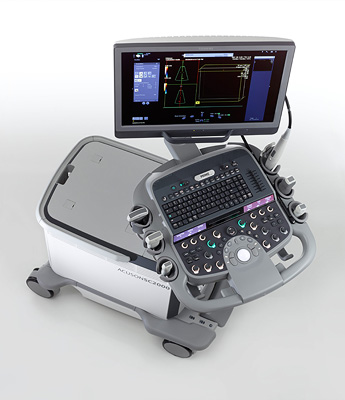New Siemens ultrasound system visualizes entire blood flow during valve procedures

Acuson SC2000 Prime Edition is the first to offer live full-volume color Doppler imaging of heart valve anatomy and blood-flow using a new true volume transesophageal echo (TEE) probe. With this technology, physicians can obtain a more anatomically authentic view of the heart and dynamic blood flow in one view during interventional valve procedures, even in patients with ECG abnormalities.
Siemens Healthcare introduces the new Prime edition of its Acuson SC2000 ultrasound system at the annual congress of the European Society of Cardiology (ESC). This new release of the premium cardiovascular imaging system is the first to offer live full-volume color Doppler imaging of heart valve anatomy and blood-flow using a new true volume transesophageal echo (TEE) probe.
With this technology, physicians can obtain a more anatomically authentic view of the heart and dynamic blood flow in one view during interventional valve procedures, even in patients with ECG abnormalities. This helps them to make faster and more accurate critical decisions.
During 3D TEE imaging, the physician guides a flexible probe into the esophagus to acquire close-range, detailed pictures of the heart to assess valve function. When a dysfunctional valve leaks blood back into the heart chambers (known as regurgitation) or does not open properly to let through sufficient blood, a valve procedure may be necessary to repair or replace the valve with an artificial one. TEE is used to guide placement of devices such as mitraclips and artificial valves during cardiac interventions to correct valve dysfunction.
Current methods of imaging with 3D TEE require stitching – the fusion of multiple heartbeats – to form a complete image of heart function and blood flow. This gated acquisition eliminates almost all patients with any ECG abnormalities and often results in image artifacts, which may skew results. However, the new Z6Ms true volume TEE probe on the Acuson SC2000 Prime is the first Siemens transducer to use true volume 3D TEE with 90° x 90° real-time acquisition and volume color Doppler, enabling full 3D images of the heart, in every heartbeat without stitching.
By eliminating the need for multiple beats to form an image and adding volume color Doppler capabilities, the Z6Ms true volume TEE probe allows the surgeon to visualize and assess blood flow in real-time during a procedure to make sure the repaired or replaced valve is working properly, potentially reducing the need for a secondary intervention to correct any remaining regurgitation.
“Volume color Doppler is extremely important,” says Dr. Lissa Sugeng, Associate Professor of Medicine at Yale University. “With Siemens' new volume acquisition, I can see the entire valve, locate the regurgitant jet, and assess the size of the orifice very quickly so that we can continue with the procedure.”
Also introduced for the first time on the Acuson SC2000 Prime is eSie Valves advanced analysis package, an automated software to measure heart valves during cardiac procedures. While standard quantification software takes several minutes to provide measurements of heart valves, eSie Valves provides automated measurements for the aortic and mitral valves in seconds1. This quantitative information allows physicians to quickly and easily evaluate valvular anatomy and physiology, which aids in device sizing and surgical repair.
“We're extremely proud of what the Acuson SC2000 Prime enables physicians to do in the detection and treatment of valvular disease,” says Dr. Jeffrey Bundy, CEO, Siemens Ultrasound. “We are aiming to provide tools with standard-setting performance and workflow, equipping physicians to focus on their patients and explore new and more efficacious procedures.”
The new PRIME technologies including the Z6Ms true volume TEE transducer and the eSie Valves package are also available as an upgrade for users of previous versions of the Acuson SC2000 system.
For further information on ESC, please see www.siemens.com/press/esc2014
1 Results may vary. Data on file.
The Siemens Healthcare Sector is one of the world's largest suppliers to the healthcare industry and a trendsetter in medical imaging, laboratory diagnostics, medical information technology and hearing aids. Siemens offers its customers products and solutions for the entire range of patient care from a single source – from prevention and early detection to diagnosis, and on to treatment and aftercare. By optimizing clinical workflows for the most common diseases, Siemens also makes healthcare faster, better and more cost-effective. Siemens Healthcare employs some 52,000 employees worldwide and operates around the world. In fiscal year 2013 (to September 30), the Sector posted revenue of 13.6 billion euros and profit of 2.0 billion euros. For further information please visit: http://www.siemens.com/healthcare
The products/features (here mentioned) are not commercially available in all countries. Due to regulatory reasons their future availability cannot be guaranteed. Further details are available from the local Siemens organizations.
Reference Number: HCP201408028e
Contact
Ms. Kathrin Palder
Healthcare Sector
Siemens AG
Henkestr. 127
91052 Erlangen
Germany
Tel: +49 (9131) 84-5337
Media Contact
All latest news from the category: Medical Engineering
The development of medical equipment, products and technical procedures is characterized by high research and development costs in a variety of fields related to the study of human medicine.
innovations-report provides informative and stimulating reports and articles on topics ranging from imaging processes, cell and tissue techniques, optical techniques, implants, orthopedic aids, clinical and medical office equipment, dialysis systems and x-ray/radiation monitoring devices to endoscopy, ultrasound, surgical techniques, and dental materials.
Newest articles

Properties of new materials for microchips
… can now be measured well. Reseachers of Delft University of Technology demonstrated measuring performance properties of ultrathin silicon membranes. Making ever smaller and more powerful chips requires new ultrathin…

Floating solar’s potential
… to support sustainable development by addressing climate, water, and energy goals holistically. A new study published this week in Nature Energy raises the potential for floating solar photovoltaics (FPV)…

Skyrmions move at record speeds
… a step towards the computing of the future. An international research team led by scientists from the CNRS1 has discovered that the magnetic nanobubbles2 known as skyrmions can be…





















